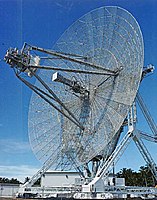
Photo from wikipedia
ABSTRACT This letter first attempts to simultaneously reduce range ambiguities and sidelobes in spaceborne synthetic aperture radar (SAR). Two of the limitations of SAR are the range ambiguity phenomenon and… Click to show full abstract
ABSTRACT This letter first attempts to simultaneously reduce range ambiguities and sidelobes in spaceborne synthetic aperture radar (SAR). Two of the limitations of SAR are the range ambiguity phenomenon and the sidelobes effect. The range ambiguity appears with long delayed echoes. The current transmitted signal does not contribute to the reflected echo that is received after the transmission of one or more new pulses. Moreover, the conventional radar commonly uses linear frequency modulated (LFM) waveforms, producing a peak sidelobe ratio (PSLR) of −13.25 dB. Unfortunately, the sidelobes in SAR imagery contribute to speckle and interfere with nearby scatterers. This letter investigates the opportunity of designing the transmitted signals using orthogonal non-linear frequency modulated (ONLFM) waveform. The results demonstrate that ONLFM signals outperform conventional LFM signal. Using the proposed ONLFM waveforms, the PSLR is reduced to −50.25 dB, meanwhile the range ambiguities can be greatly suppressed, despite broadening the mainlobe.
Journal Title: Remote Sensing Letters
Year Published: 2018
Link to full text (if available)
Share on Social Media: Sign Up to like & get
recommendations!